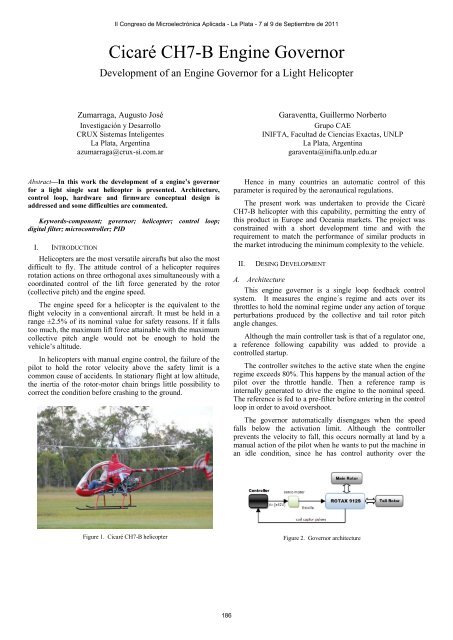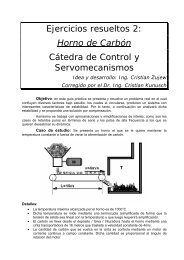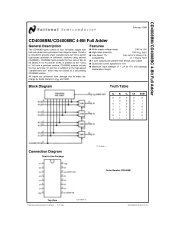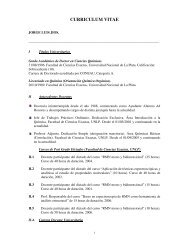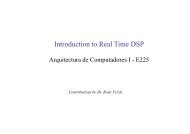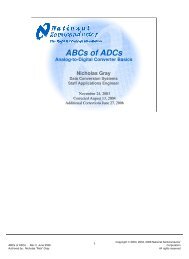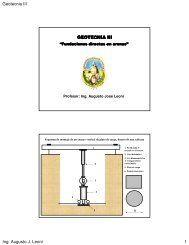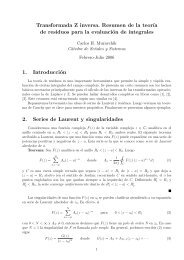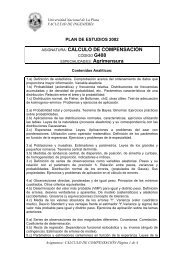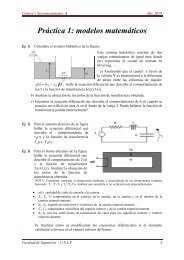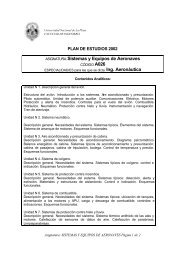Memorias - Facultad de IngenierÃa - Universidad Nacional de La Plata
Memorias - Facultad de IngenierÃa - Universidad Nacional de La Plata
Memorias - Facultad de IngenierÃa - Universidad Nacional de La Plata
You also want an ePaper? Increase the reach of your titles
YUMPU automatically turns print PDFs into web optimized ePapers that Google loves.
II Congreso <strong>de</strong> Microelectrónica Aplicada - <strong>La</strong> <strong>Plata</strong> - 7 al 9 <strong>de</strong> Septiembre <strong>de</strong> 2011<br />
Cicaré CH7-B Engine Governor<br />
Development of an Engine Governor for a Light Helicopter<br />
Zumarraga, Augusto José<br />
Investigación y Desarrollo<br />
CRUX Sistemas Inteligentes<br />
<strong>La</strong> <strong>Plata</strong>, Argentina<br />
azumarraga@crux-si.com.ar<br />
Garaventta, Guillermo Norberto<br />
Grupo CAE<br />
INIFTA, <strong>Facultad</strong> <strong>de</strong> Ciencias Exactas, UNLP<br />
<strong>La</strong> <strong>Plata</strong>, Argentina<br />
garaventa@inifta.unlp.edu.ar<br />
Abstract—In this work the <strong>de</strong>velopment of a engine’s governor<br />
for a light single seat helicopter is presented. Architecture,<br />
control loop, hardware and firmware conceptual <strong>de</strong>sign is<br />
addressed and some difficulties are commented.<br />
Keywords-component; governor; helicopter; control loop;<br />
digital filter; microcontroller; PID<br />
I. INTRODUCTION<br />
Helicopters are the most versatile aircrafts but also the most<br />
difficult to fly. The attitu<strong>de</strong> control of a helicopter requires<br />
rotation actions on three orthogonal axes simultaneously with a<br />
coordinated control of the lift force generated by the rotor<br />
(collective pitch) and the engine speed.<br />
The engine speed for a helicopter is the equivalent to the<br />
flight velocity in a conventional aircraft. It must be held in a<br />
range ±2.5% of its nominal value for safety reasons. If it falls<br />
too much, the maximum lift force attainable with the maximum<br />
collective pitch angle would not be enough to hold the<br />
vehicle’s altitu<strong>de</strong>.<br />
In helicopters with manual engine control, the failure of the<br />
pilot to hold the rotor velocity above the safety limit is a<br />
common cause of acci<strong>de</strong>nts. In stationary flight at low altitu<strong>de</strong>,<br />
the inertia of the rotor-motor chain brings little possibility to<br />
correct the condition before crashing to the ground.<br />
Hence in many countries an automatic control of this<br />
parameter is required by the aeronautical regulations.<br />
The present work was un<strong>de</strong>rtaken to provi<strong>de</strong> the Cicaré<br />
CH7-B helicopter with this capability, permitting the entry of<br />
this product in Europe and Oceania markets. The project was<br />
constrained with a short <strong>de</strong>velopment time and with the<br />
requirement to match the performance of similar products in<br />
the market introducing the minimum complexity to the vehicle.<br />
II.<br />
DESING DEVELOPMENT<br />
A. Architecture<br />
This engine governor is a single loop feedback control<br />
system. It measures the engine´s regime and acts over its<br />
throttles to hold the nominal regime un<strong>de</strong>r any action of torque<br />
perturbations produced by the collective and tail rotor pitch<br />
angle changes.<br />
Although the main controller task is that of a regulator one,<br />
a reference following capability was ad<strong>de</strong>d to provi<strong>de</strong> a<br />
controlled startup.<br />
The controller switches to the active state when the engine<br />
regime exceeds 80%. This happens by the manual action of the<br />
pilot over the throttle handle. Then a reference ramp is<br />
internally generated to drive the engine to the nominal speed.<br />
The reference is fed to a pre-filter before entering in the control<br />
loop in or<strong>de</strong>r to avoid overshoot.<br />
The governor automatically disengages when the speed<br />
falls below the activation limit. Although the controller<br />
prevents the velocity to fall, this occurs normally at land by a<br />
manual action of the pilot when he wants to put the machine in<br />
an idle condition, since he has control authority over the<br />
Figure 1. Cicaré CH7-B helicopter<br />
Figure 2. Governor architecture<br />
186


